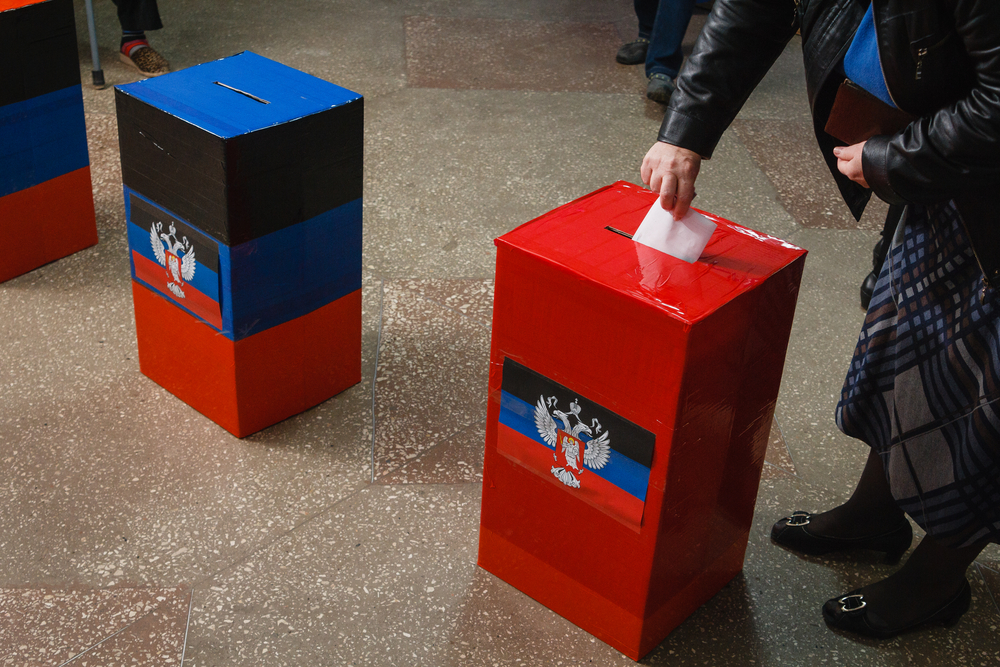Is Everything Going According to Plan?
The destabilisation of south-eastern Ukraine has not been so successful. From eight regions where the pro-Russian mood prevailed, only two remain under control of separatist forces – Luhansk and Donetsk oblasts.
May 14, 2014 -
Paweł Pieniążek
-
Articles and Commentary

May 9th was Victory Day – the celebration of the Soviet victory over Nazi Germany. The holiday was celebrated throughout all of Ukraine, just as in all countries of the former Soviet Union. In Ukraine, this day is often a time of riots and conflicts between two groups – chauvinistic post-Soviets and Ukrainian nationalists. This year, the understanding of the “fight against fascism” had a new sense according to the pro-Russian activists. For them, the government and the politicians who took power after the EuroMaidan protests are the “fascists” and the “Kyiv junta” is enemy number one. So it is no surprise that during this year’s celebrations, everybody was expecting a bloody day in Ukraine. Yet, the reality was not as bad as was predicted.
Eight regions are at risk of separation – Kharkiv, Luhansk, Donetsk, Zaporizhia, Kherson, Mykolaiv and Odessa. Many observers believed that clashes would erupt in all eight regions during the May 9th commemorations, with separatists occupying public buildings and continuously provoking the authorities. In some of the regions, there had been serious fights before. Unity marches were held in Kharkiv and Odessa, organised by the “Ultras” – radical football fans. After several minutes, they were attacked by pro-Russian hooligans. The militia forces did not react to acts of violence and in some cases even supported the attackers. Usually by the end, the stronger forces of the Ultras were defeated by the much smaller number of separatists. Generally speaking, these “victories” were achieved without serious injuries or deaths.
The largest tragedy took place in Odessa on May 2nd, where more than forty people lost their lives. Some of them were killed during street clashes, the rest burned when the trade union building was set on fire – some of them jumped out of a window, others died because of fire or smoke. Who burned this building? Most supporters of Russia strongly believe that it was done by the “fascist”. The other side blames the accident on the pro-Russian hooligans who were throwing Molotov cocktails from the roof of this building. Which version is correct? No one knows for sure. The tragedy in Odessa gave another reason to attack supporters of Ukrainian unity. “We do not forgive for Odessa,” the pro-Russian marches now chant.
Nevertheless, May 9th was not a day of new conflict in the main cities of the regions. Clashes were expected in Kharkiv, Odessa, Donetsk and Lugansk, but they did not happen. In Kharkiv, for example, people marched all day with a giant Saint George ribbon (nearly two hundred metres in length). Those marching shouted: “Fascism will not pass”, “Thank you grandpa for victory”, and so on. New slogans were also shouted, connected with the present situation: “Sloviansk: city-hero” and “Donbas, thank you”.
This day, the pro-Russians owned the city. But there was one important difference: the streets were kept safe by the police. Usually passive and not interested in what is happening, the police forces began working to keep the city safe. In Kharkiv alone, there were more than five thousand officers. A similar situation was in Odessa, where after the tragedy of May 2nd, the disposition of the local police had changed.
On May 9th, there was only one really serious flashpoint – Mariupol. A few days earlier, Ukrainian National Guard forces captured the city from the hands of separatist forces. After this, the Ukrainian forces left the city. The separatists rebuilt barricades and re-occupied public buildings. There was also some violence – several people were killed and many more wounded. The following morning, the National Guard left Mariupol altogether.
After May 9th, it was certain that the referendum would not be held in all of the south-eastern regions of Ukraine due to the lack of support. In Kharkiv, the separatists refused the idea of a referendum. The majority of people there are oriented on uniting Ukraine, but they want more protections for Russian speaking citizens.
Only in the Donetsk and Luhansk regions, was there enough support to hold the referendum. Exactly how big was the support? Nobody knows for sure. The self-appointed officials of the “Donetsk People’s Republic” said that in the Donetsk region, turnout was about 75 per cent with 90 per cent of the vote favouring independence of the republic. If the latter claim was true, the former certainly is not. In Mariupol, there were rumours of serious clashes between separatist forces and Ukrainian forces, allowing only five per cent of the people to vote. In Donetsk there was a slight crowd. The referendum, however, was held during the long holiday weekend, so a lot of citizens of the region were outside at their dachas.
The self-appointed officials do not know what to do now after the referendum. At first, there was talk about a second referendum to link the Donetsk People’s Republic to Russia. But at the moment, it seems that they are now promoting the idea to join Russia without any referendum.
Russia, at least in official statements, does not show great interest in having more regions join the Russian Federation. Clearly, without serious support from the Kremlin, the Donetsk People’s Republic cannot exist. It may so happen that the new republic could have a really short story.
Paweł Pieniążek is a Polish journalist specialising in Eastern Europe. He is a contributor with the Polish daily Dziennik Opinii, New Eastern Europe and the Polish magazine W Punkt.

































